#Radially Symmetrical
Explore tagged Tumblr posts
Text






These idiots can’t even fucking see. Float around. Dumb sessile radially symmetrical hydrozoan. 🙄👎
88 notes
·
View notes
Text
Radial Art, Perfect Loop of Kaleidoscope Video
🔔 Click to Subscribe to Kaleidoscope Visual YouTube Channel 📺 Colorful Kaleidoscope Visual Videos
#seamless loop#perfect loop#kaleidoscope#kaleidoscope visuals#mandala art#radial symmetry#symmetrical pattern#abstract art#animated art#万華鏡#radial art#radial balance#animated loop#art
9 notes
·
View notes
Text
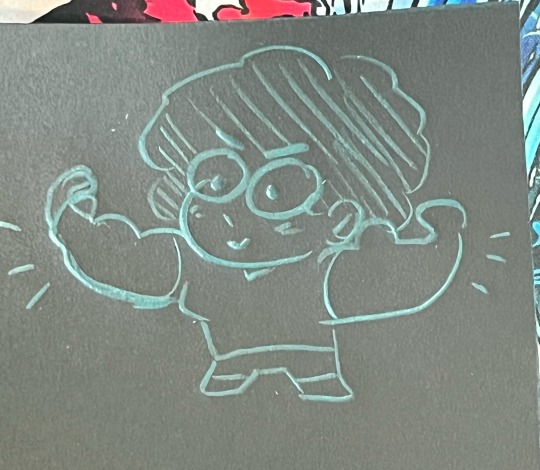
Buff arms
#I survived the notans#I had to make six of them#they aren’t difficult but I was busy getting lost on campus#and then in Spanish class from 6-830#then kinda forgot about them until 10pm#uhh anyway I finished the last 4 I needed#I CANNOT tell the difference bwteeen symmetrical & Asymmetrical notans#they look the same#I watched a video of someone doing it & the piece placement looked the same#I needed 2 of each type of balance (symmetry asymmetry & radial)#🍞🍞#there are notifs I need to look at but that will be my treat for doing the rest of these assignments#my spanish vocab quiz opens in like 10 min so I might as well do that first#coconut octo (mod talking)#thank you Splatoon music & Hansel (Sodikken) for keeping me alive#also the teenage mutant ninja turtles (2012)#shout out to them <3
4 notes
·
View notes
Text
🍄 MYCONIDS 🍄 SHOULD 🍄 NOT 🍄 BE 🍄 PLANTS 🍄

who let biologists play dnd
#the coral argument is interesting but I think I'd require a bilaterally or radially symmetrical body plan for wild shape#which I don't think coral is?#I'd have to research / think (on a train atm)#I reckon for a siphonophore or other mutualistic/colonial animal I'd require a side quest of some kind
62K notes
·
View notes
Text
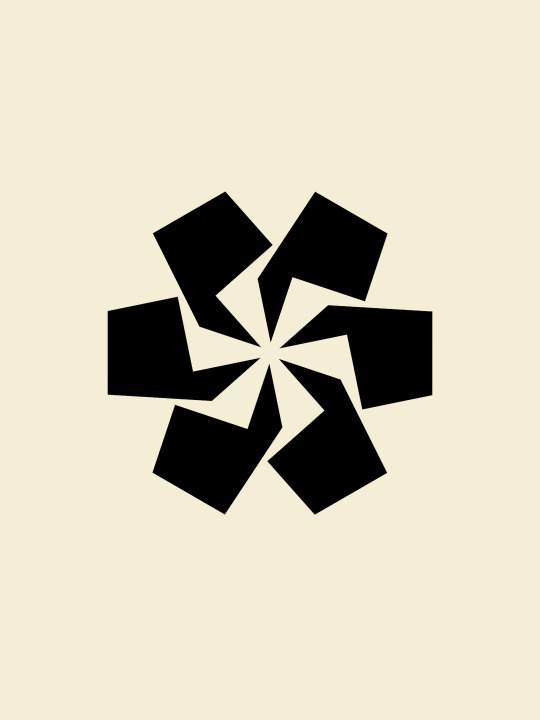
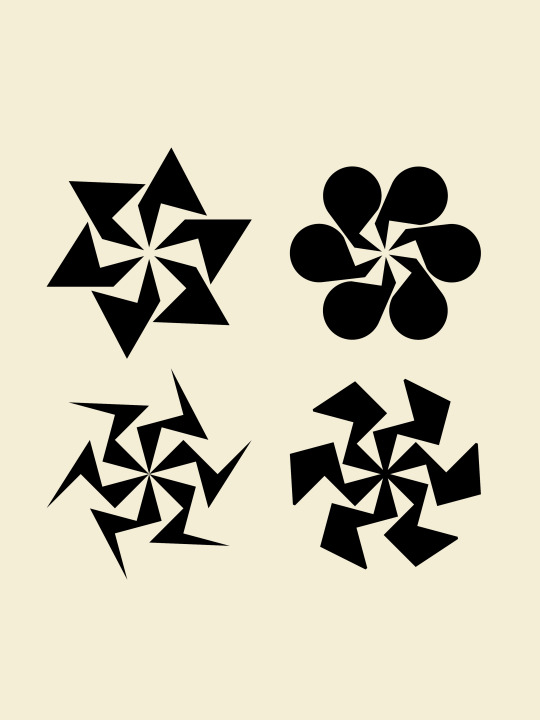
🎉 Your project is around special effects
#star#radial#spiral#helix#spread#spreading#symmetric#asterisk#freelogo#freepictogram#logos#icons#pictograms#custombrandingsystems
0 notes
Photo



(via "Carnival Red Pink Blue Symmetrical Flower" Magnet for Sale by ellenhenry)
0 notes
Text
TIL that echinoderms are bilaterians
0 notes
Text
Wet Beast Wednesday: sea urchins
As I continue the slow grind of covering every living group of echinoderms for this series, it was inevitable that I would eventually encounter the only echinoderm I've actually studied. Sea urchins are among the most iconic of marine invertebrates, but many people just think of them as part of the scenery. I'm here to show you that there's more to these creatures than just being spiny lumps on a rock.

(Image: a purple sea urchin (Strongylocentrotus purpuratus) being held in someone's hand. It is a round, globular animal with a dark purple color. Light purple spines emerge from it all over its body, with the longest being around the middle. End ID)

(image: a long-spined sea urchin (Diadema savignyi). It is a black sea urchin with spines longer than its diameter. End ID)
Urchin is an old-fashioned word for hedgehog, and sea hedgehog is a fitting name for these round, spiny animals. Sea urchins tend to be fairly small, with a diameter of 3 - 10 cm (1 - 4 in), though some species have very long spines that make them seem larger. The main body of an urchin is round and enclosed in a (usually) hard shell called a test made of calcium carbonate. The test is covered with a slayer of skin and muscle that controls the spines and small, pincer-like structures called pedicellaria. Within the test are the internal organs. As with other echinoderms, sea urchins are radially symmetrical as adults, with five segments arranged around the center like pizza slices. The two main body holes are found on the top and bottom of the animals where the segments converge. At the bottom is the mouth and at the top is the anus. Each segment also has a hole near the anus used to release gametes and one will have a larger pore called the madreporite, which is used to control the amount of water within the urchin's body. The mouth is a unique structure known as Aristotle's lantern, consisting of five tooth-like structures (one for each body segment) that interlock together and sharpen themselves. Behind the teeth is a rasping tongue.

(image: a close-up of an urchin's mouth, showing the Aristotle's lantern. It is a hole surrounded by a fleshy lip. Five spade-shaped teeth are emerging from the edge of the hole. End ID)
Internally, most of the body is taken up by the digestive tract and water vascular system. The digestive system lacks a stomach, with the esophagus attaching directly to the small intestine. The digestive tract forms a loop as it passes through the body. The water vascular system uses seawater to form hydrostatic pressure that moves the tube feet. All starfish, urchins, and sea cucumbers have tube feet, small, transparent, tentacle-like structures they use for movement. Tube feet are hollow and retracted into pores on the skin normally. To be used, they have to be inflated with water, which makes them stick out of the body, where they can be controlled with muscles. Tube feet end in suction cups that can be used to grab into structures around them. Seawater drawn in through the madreporite serves as the source of pressure needed for the tube feet to function. In urchins, tube feet cover the body and are used for locomotion, moving food to the mouth, and moving objects on or off the body. The main body cavity is filled with circulatory fluid that uses special cells to move oxygen and nutrients around the body. The nervous system is simple, consisting of a central nerve ring around the esophagus that branches into nerves that connect to the rest of the body. Urchins have no eyes (except for the family Diadematidae, which have eyespots), but are sensitive to light. The gonads are usually small, but during mating season they can swell to fill much of the body cavity.

(Image: a drawn diagram showing a cross-section of a sea urchin, with the different organs and body parts labeled. End ID. Source)
Sea urchins are found in oceans worldwide, from intertidal zones to the deep sea and the tropics to the poles. They are bottom-dwellers who feed primarily on algae, which they scrape up with their teeth. However, they will also take a variety of food, including carrion, aquatic plants, and other slow-moving or sessile animals like sponges, polyps, bivalves, worms, and sea cucumbers. Urchins can play a key role in regulating algae populations through their ecosystems, but they also rely on predators to keep from overeating necessary algae. Famously, California's kelp forests were almost destroyed by urchins eating the kelp after their primary predator, sea otters, were driven to near extinction. Urchin's primary defense against predators is their hard tests and spines. As most of the edible portion of the urchin is within the test, predators have to get through both layers of defense first. The spines are hollow and each can be moved independently of each other, allowing them to be positioned toward a threat. Many species contain venom within their spines as an added layer of defense. This venom is rarely dangerous to humans, but can cause swelling and painful reactions. Another layer of defense is the pedicellaria, which are good at removing small animals and parasites from the skin. The flower urchin, Toxopneustes pileolus, has modified its pedicellaria into flower-like structures that extend beyond the spines and can deliver a sting that can be fatal to humans.

(Image: a flower urchin. It is a pinkish urchin covered with flower-like structures that extend to the length of the spines. It has placed some bits of shells on top of it. End ID)
Sea urchins possess distinct males and females, though the differences are internal, making it impossible to tell which is which based on visual examination. During mating seasons, the gonads swell as they generate gametes. Urchins tend to reproduce in groups at synchronized times (possibly correlated with the phases of the moon in shallow-water species) to maximize the possibility of fertilization. When ready to mate, the gametes are squeezed to empty their contents through the genital pores and into the water column. Sperm must find egg in the water to fertilize it. Most sea urchins provide no parental care, but in some species, the female will retain the eggs in her spines to protect them. The eggs hatch into bilaterally symmetrical larvae called plutei that drift with the plankton. As they develop, a section of the larvae will develop into a radially symmetrical adult rudiment. This piece will eventually break off and become the juvenile urchin while the rest of the larva dies. Because echinoderms start out as bilaterally symmetrical larvae, we can infer that they developed from bilaterally symmetrical ancestors and the radial symmetry of adults is a more recent development.

(image: a series of photos showing the embryological development of a sea urchin from a single cell to a cluster of cells, to a bell-like structure, to growing several arms, to the eventual adult developing and breaking off. End ID. Source)
Fossils show that the oldest sea urchins had large, club-like spines that they walked on, with the modern spines being a later development. Most of those urchins died out with the dinosaurs, leaving the pencil urchins of order Cicaroida as the only living members. All other living urchins are Part of the clade Euechinoidea. Amongst them, there are still some oddballs, known as the irregular urchins of clade Irregularia. These urchins have moved away from radial symmetry, with less symmetrical segments and the anus and mouth moving from being on the top and bottom to being on the sides in the heart urchins. Heart urchins have gone from bilateral symmetry to radial symmetry and are now going back to bilateral symmetry. Heart urchin mouths don't have an Aristotle's lantern. Instead, they use strands of mucus to capture food and cilia to pull the strands back inside. Sand dollars, also known as sea cookies or sea biscuits, are also in this clade. These are flattened urchins with short and very fin spines that resemble velvet. They are burrowers who spend much of their time buried under sand and as such are rarely seen alive. The name sand dollar comes from their tests, which are similar to old dollar coins and can often be found washed up on beaches. While still radially symmetrical, sand dollars also have a secondary form of bilateral symmetry, with a distinct front and back end that often look different. Irregular sea urchins also tend to have fewer gonads and associated pores than regular sea urchins.

(image: a red pencil urchin (Heterocentrotus mamillatus) nestled among coral. Instead of spines, it has a series of long, thick, red clubs. End ID)

(image: a purple heart urchin (Spatangus purpureus). It is an urchin elongated on one direction and with a few rows of long spines amongst short ones. On the surface facing the camera is a large hole that could be the mouth or the anus. End ID)

(image: a group of irregular sand dollars (Dendraster excentricus) partially buried in the sand. They are round, flat animals with a velvety covering of tiny spines. The are sticking out of the sand. End ID)
Sea urchins have been known to humans for as long as people have lived near the ocean. Stings can occur when people step on them and can cause pain and irritation, but are rarely medically significant. That being said, some people can have allergies to the venom, which could be a big problem. Spines left in the wound should be removed, as they can continue injecting venom. Urchins are a food source for people around the world, specifically the gonads, which are the only meaty part of the animal. The gonads are often marketed as roe or corals and can be eaten raw or cooked. Urchins are also used as a model organism in embryology due to the interesting and well-studied nature of their larval development. Urchins are vulnerable to pollution, habitat loss, and over-predation. Ocean acidification due to climate change poses a major threat to them, as it reduces the quality of their tests.

(image: tow sea urchins served as food. They are upside-down with the bottoms removed. The gonads are visible within as five orange, spongy structures that take up most of the body cavity. End ID)
#wet beast wednesday#sea urchin#urchin#sea urchins#echinoderms#invertebrates#invertiblr#sand dollar#heart urchin#pencil urchin#marine biology#marine life#biology#zoology#ecology#animal facts#informative#educational#image described
829 notes
·
View notes
Text
ohhh I love them. cucombre
marine invertebrates truly are a great resource for inspo on non-standard alien body types, I have my own radial guys who are obviously based on brittle stars and other echinoderms in their group.
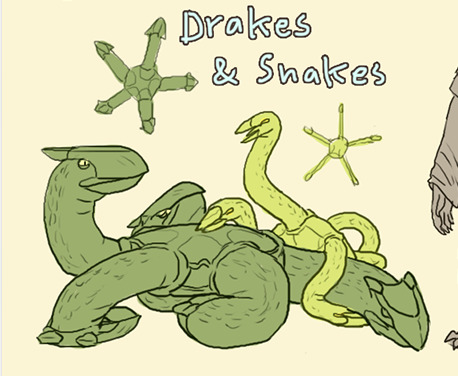
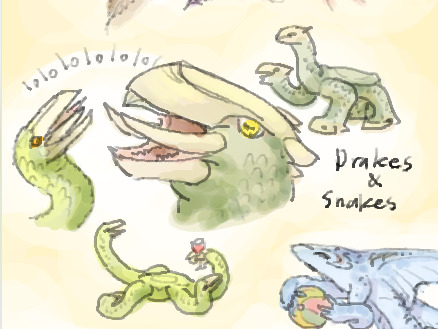
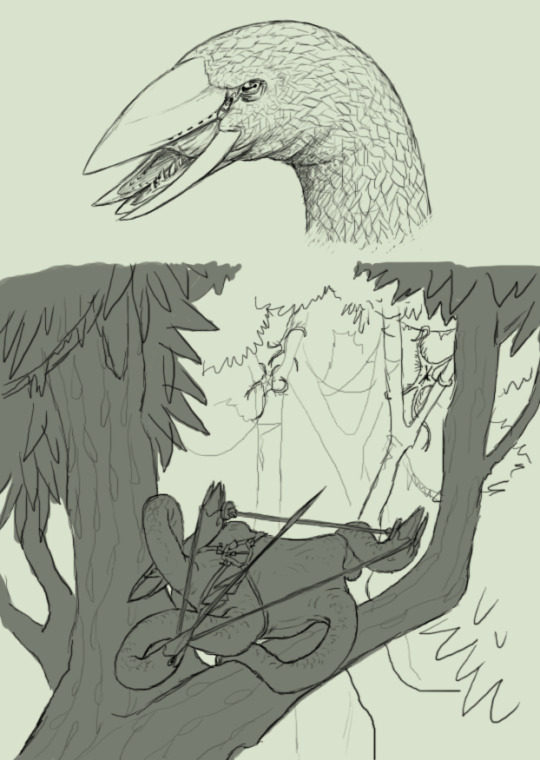
they need a lot of reworking still but I'm fond of them; they're two separate species that co-evolved into sapience via much the same sort of social symbiosis as monkeys and antelopes on Earth, and now traditionally live in lifelong snake-drake pair bonds
show me radially symmetrical creatures/sophonts
bilateral symmetry is pretty common, I mean. we are bilaterally symmetrical (on most part, obviously our internal organs like heart placement and how intestines are organized are very much not so, not to mention fluctuating asymmetries). but radial symmetry in creature design and spec bio is something I don't see as much.
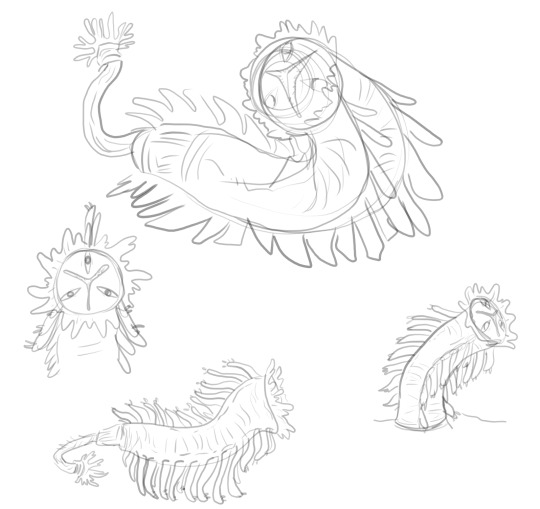
anyway last time I made a radially symmetrical thing was this "lion" with a sort of triskelion thing going on.

@jarofwyrms also drew this cool art of the lion, making the sea anemone influence even more obvious.
anyway jesus I gotta make more weird creatures.
#New Eight Worlds#creatures#planet Dracoa#also I guess the Covorayl are radially symmetrical if you count a rotation of 180° since they have quadrilateral symmetry lol
64 notes
·
View notes
Photo
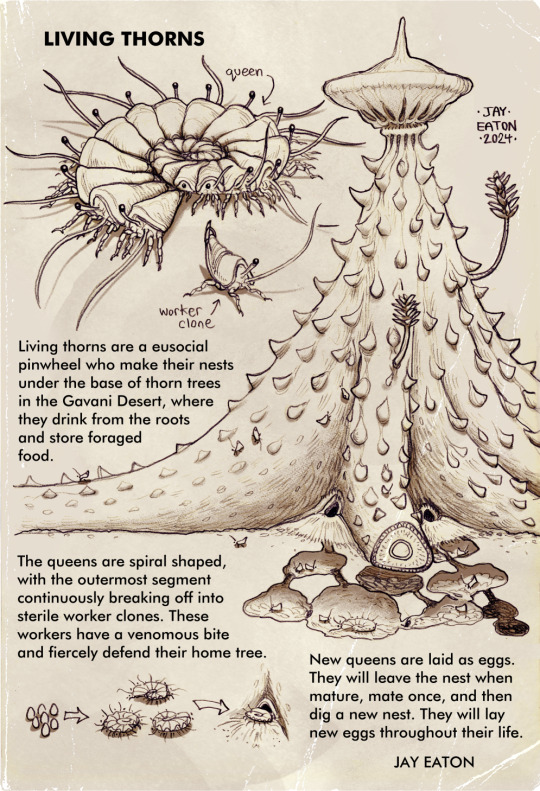
Simon Roy (@simon-roy) asked me to invent a guy (alien organism) for his newest book, Refugium, which comes with a guy emporium (alien life guidebook). There's a kind of radially symmetrical bug called pinwheels on the planet that will split into wedges as a defensive mechanism, so I Junji Ito'ed them into a eusocial spiral that workers snap off of once "ripe."
Refugium is out on Kickstarter right now and if you like alien ecology, failed utopias, and frontier stories I can highly recommend it. I've greatly enjoyed the previous books from the same universe.
#speculative biology#speculative evolution#spec bio#specbio#spec evo#specevo#scifi#hard scifi#aliens#alien#refugium
2K notes
·
View notes
Text
This just in, starfish are a radially symmetrical head with a stomach.
God I love echinoderms
If you told someone that there’s an entire group of animals that develop butt first as embryos are born bilateral but then grow a radially symmetrical head like a cancer in their side that then bursts out and lives as a completely separate organism from its birth form and moves via hydraulic systems…
They wouldn’t believe you. Yet one of the most beloved cartoon characters is one of them.
#biology#genomics#genome#genomes#genome sequencing#evolutionary biology#echinoderm#starfish#asteroidea#bilateria#Deuterostome#Deuterostomia
5K notes
·
View notes
Text
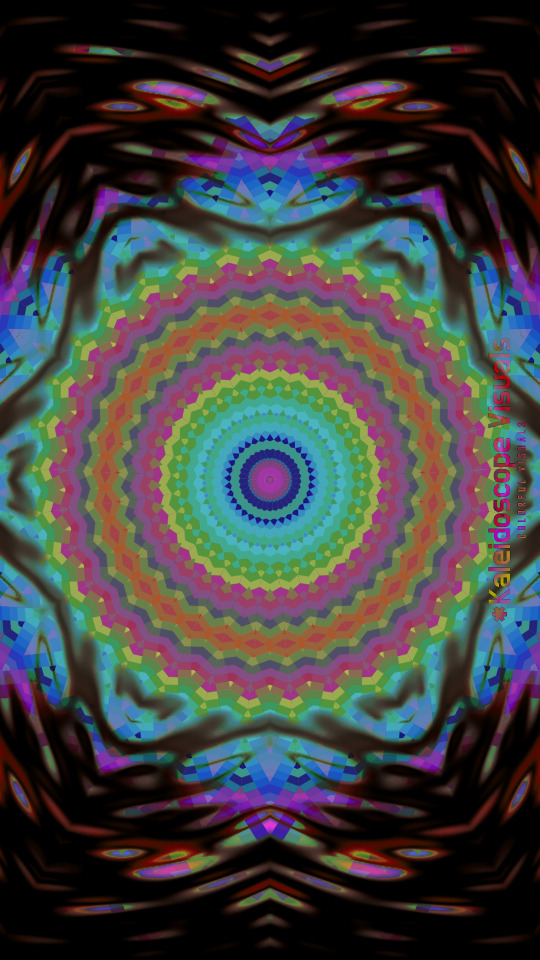
📌 📺 Symmetrical Pattern, Kaleidoscope Visual with Ambient Music, Radial Symmetry Art, Abstract Waves
#art#artwork#abstract#kaleidoscope#digitalart#kaleidoscopeart#abstractart#kaleidoscopevisuals#Kaleidoscope Visual Art#Symmetrical Pattern#Kaleidoscope Visual with Ambient Music#Radial Symmetry Art#Abstract Waves
8 notes
·
View notes
Text

Okay, here comes the first of MANY aliens I will need to introduce very gradually, but here goes the formal introduction to one of my many sophont alien species: the Tuiouli.
The Tuiouli are a sapient worm-like species originating from a distant alien moon called Fruuluu. Fruuluu"s biosphere circulates carbon dioxide and methane in place of oxygen and carbon dioxide (a reductive loop). In addition to this, the moon is covered in sizeable lakes of concentrated sulfuric acid, which the Tuiouli use as a solvent to carry out biological functions. Despite this, they are still carbon-based.
Uniquely, the Tuiouli themselves exhibit a strange form of symmetry wherein they have two heads, one on each end, although they still share one single mind. They evolved from radially-symmetrical ancestors but have gradually begun to lose this quality. On Fruuluu, they evolved as amphibious swamp- and lake-dwelling lifeforms who subsisted on smaller organisms.
They are the second smallest sophonts in Ruminaaan Space, reaching upwards of around 70 centimetres. Due to poor previous historical encounters with mysterious unidentified extraterrestrials on top of their natural fear of the unknown born from being heavily preyed upon in their prehistory, as well as other factors such as their radically differing biology, they don't intermingle with other Ruminaaan empires very much and historically tend to keep to themselves.
#aliens#alien#spec evo#specbio#speculative biology#xenobiology#alien person worldbuilding#ruminaaan theomachy#worldbuilding#my art#sophont#sophonts#scifi#science fiction#sci-fi#alien person spec bio
295 notes
·
View notes
Text
What does the Comic tell us About the Brute Force Toyline that Never Was?


Brute Force was Marvel's failed attempt at joining in the toy-cartoon-comic fun back in 1990.
What isn't often talked about (if ever) is how much effort Jose Delbo (and whoever else was doing character design work in pre-production) put into planning for the realities of toy design, because it's not hard to suss out what was intended from the art alone.
Parts Reuse Was Planned From the Start:
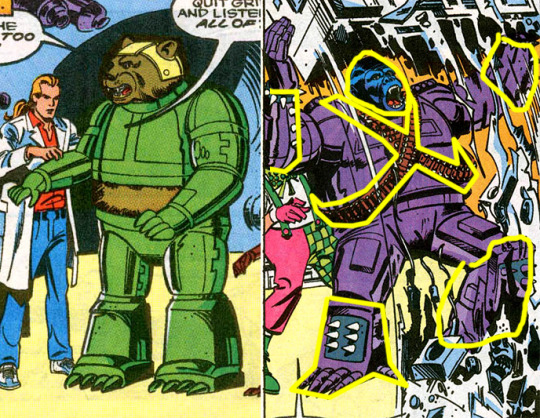
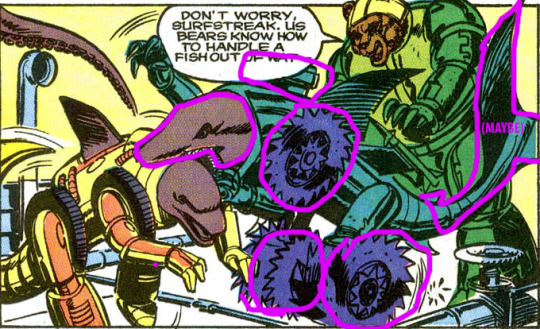
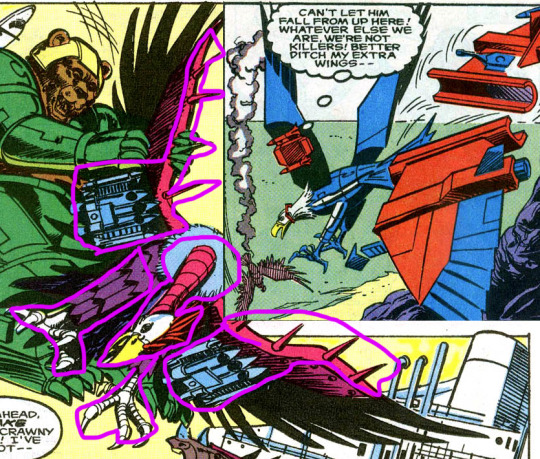
The metal production molds are the most expensive part of toy production, so any time you can reuse parts across multiple figures is a savings. Each side has two unique members (Hip-Hop and Lionheart for Brute Force, Armory and Ramrod for Heavy Metal) three that share obvious parts with an opposing figure.
Uproar and Wreckless appear to use the same upper arms, upper legs, pelvis and probably chest. Uproar's bullets were likely planned as an accessory.
Surfstreak and Bloodbath appear to just have different heads, maybe tails, and either different accessories and limbs or just different accessories depending on execution.
Soar/Slipstream and Tailgunner appear to have unique add-on armor for the wings, heads, and legs. The wings might also been different, but I'd guess that when time came to mold plastic they'd have used the same ones.
Size Classes are Easy to Guess:
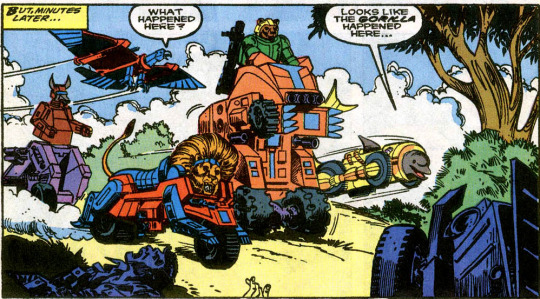
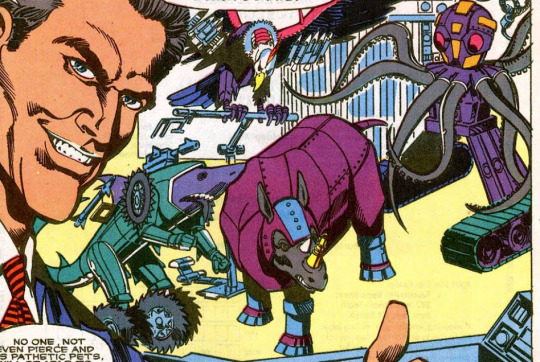
The "charge into battle" shot gives you every indication of what size everyone was going to be sold at. My guess, based on the art and the action features later shown off, is it would break down like this:
Small - Soar, Surfstream, Bloodbath, Tailgunner
Medium - Lionheart, HIp-Hop, Ramrod, Uproar.
Large - Wreckless, Armory, the toxic mutant (if they planned on making the off-theme guys)
Super Large - Heroic and Evil Transports

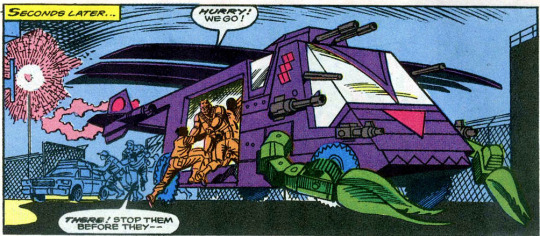
It's harder to place Heavy Metal since they don't seem to have add-on vehicles, but the art represents Armory as being huge and a major threat...
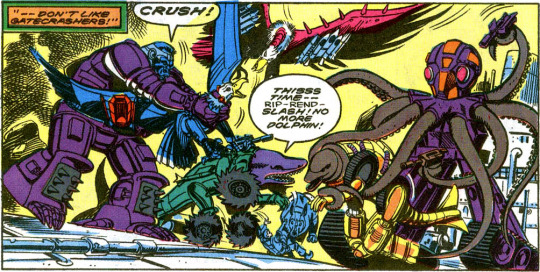
And uproar seems to have mass equal to Lionheart on his cycle, though he might have been packed in with the villain's large transport or had another add-on vehicle planned later.
It's likely that the vehicle-attached figures would have gotten solo releases, likely with different decos. As was the style at the time.
They Planned for Action Features, and I think I know what they were.
Furman and Delbo knew how to make a toy-comic, and everyone gets to show off their action feature in a toy-comic. Brute Force leaves some solid clues for what those features would have been. Now, there would probably have been launchers (Wreckless's Bearzooka), water-shooters (Surfstream almost certainly had one), etc, but I'm talking more about the showcase feature.
Surfstream and Bloodbath Were Low-Effort Transformers-
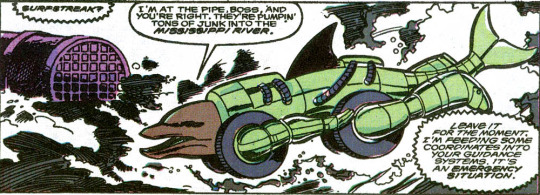
-or else they were biting MOTU Dragstor's style. Surfstream and Bloodbath clearly had both swimming/rolling configurations and upright figure configurations.
Soar (and likely Tailgunner) Had Blast-Away Armor
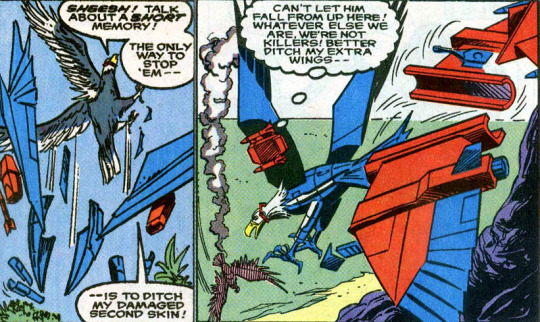
You don't do this trick twice in 4 issues if it's not your gimmick.
Wreckless and Uproar loved Hugs
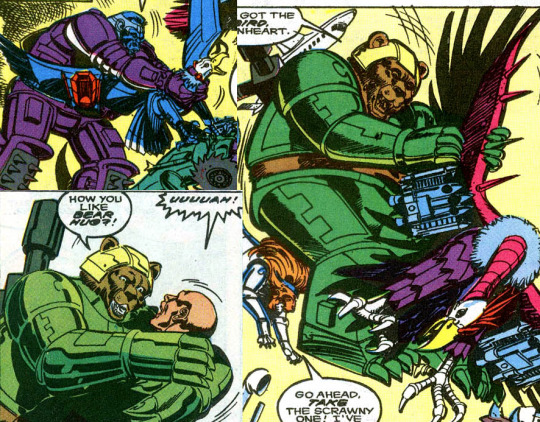
My guess is there was at least some thought put into the possibility of Wreckless and Uproar having a "bear hug" feature that could work as general limb-swinging and chest pounding. In addition to the grabs Wreckless does a lot of right hooks and, oddly Uproar mainly fights with his mace for a character with bullet bandoleers. This one's harder to nail down because the actions are very obvious for bear/ape characters, but either a weapon-swing or a grab/bear hug seems really likely.
Wreckless's gun is the kind that you could mount on a figure's shoulder without them needing to hold it in-hand, so the arms might have been free for the action feature if my guess is right.
This Octopus Bastard Spins
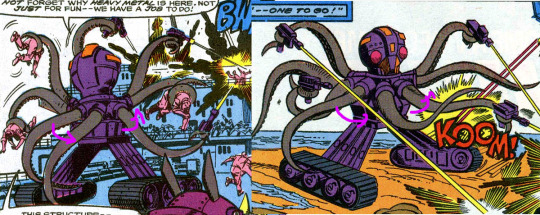
You can't tell me Armory doesn't spin. perfectly radially symmetrical middle section designed in such a way the central body could spin while the legs and head stay stationary. arms that grip weapons or other figures, he's huge and clearly meant to be Heavy Metal's mega-weapon. He spins.
Hop-To Heroes
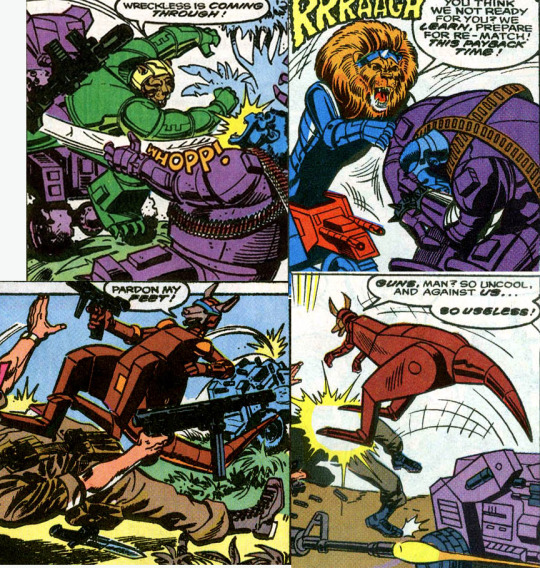
Now, if there's one thing the Brute Force characters do, it's leap. But the characters with the larger lock-on vehicle armor all leap out of the vehicle to attack a foe at least once.
I have to wonder if the vehicle figures were intended to be ejected from the vehicle as a leaping attack. (this would seem thematically in line with the armor-shed gimmick from Soar) This would be in addition to some general reconfiguration between low-riding "speed" modes and upright battle modes.
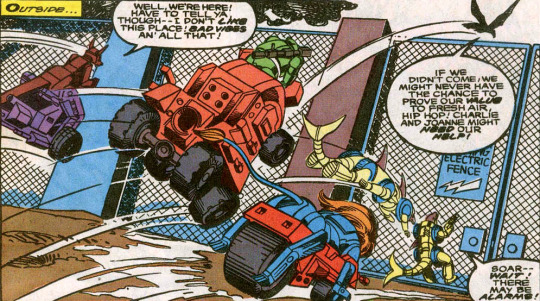
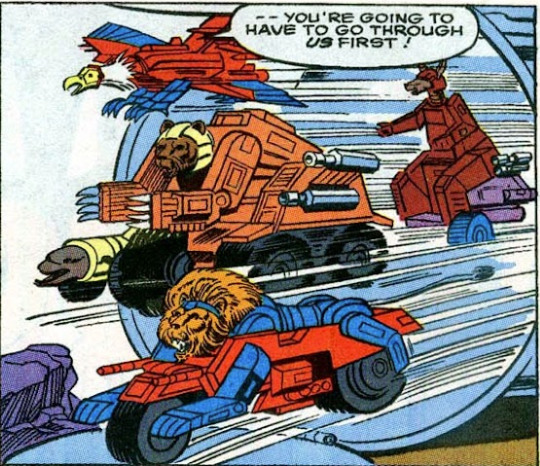
Ramrod would have had a headbutt gimmick.
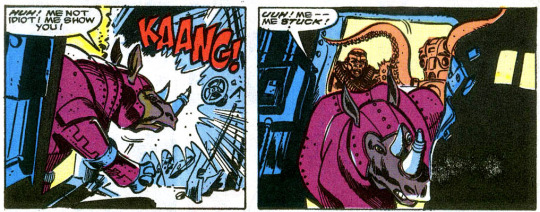
It's literally all he does in the comic. I don't think he even has a gun.
Conclusions
Brute Force was intended into be a not just an action figure line, but a feature-heavy character driven line. The play patterns imagined were ambitious. I see Starriors, Transformers and Centurions DNA in there, and it would have been a lot more fun than Captain Planet for an eco-themed franchise.
The Marvel crew clearly learned a lot from the toy industry from working with Hasbro, Kenner, Mattel, Mego and numerous others through the years, and it shows. This concept started with toy ideas, it's just a pity no one was incentivized to make them.
#Brute Force#marvel comics#heavy metal#talking animals#adverttoons#toyetic#toy design#character design#1990s#80s nostalgia#90s nostalgia#deadpool
165 notes
·
View notes
Text
Harding narrative sketches and captions by Nick Thornborrow, under a cut due to spoilers and length:
Nick Thornborrow: "Let's do a thread of Harding sketches and talk about the crazy Twine file I made. There was a visual novel style version of Veilguard's earliest story outline that was written by Trick and the writers and assembled in Twine by me. These black and white sketches are what populated the Twine file."

[artist's caption] Portrait sketch of Harding.

Harding examining an artifact in the ruins of the disrupted ritual.

Harding being struck by arcane powers.

Harding exhibiting magical abilities dispatching a demonic monster.
Nick Thornborrow: "Let's just pause and enjoy these two drawings side by side."

1 of 2. Harding deep in concentration, hands flexed trying to levitate a pebble on the ground. Rook stands by patiently in the background, hands in pockets, eyes locked on the pebble.

2 of 2. The camera has pulled way back. Harding is small in the frame, and not merely moving a pebble, but causing the entire ground to convulse in a radial pattern around her. Rook is being tossed like a ragdoll into the air.
Nick Thornborrow: "Back to the Twine file. It was meant to emulate the flow of the narrative and broadcast that narrative out to the wider team. "Here's what we're trying to make." The challenge I put on myself was to reflect the narrative branching we intended to build."

Harding carrying a torch entering a dark dwarven threshold deep underground.

Harding meeting the Oracle. The Oracle is smaller in this rendering than how she appears in game.

Harding and the Oracle communing through the stone in a strange dark and infinite sublime psychological space.

Harding briefly being overcome with rage. Her eyes gleam red, and red glowing veins glow below her skin a la video game corruption.
Nick Thornborrow: "So I did what no one asked for. You couldn't simply plow through the story. Side missions would become available on a cadence and would be assigned to numbers on a dice roll (a certain amount of variability in side content was planned in the early days of Veilguard)."

Harding being blown back by angry earth based boss monster. This was the boss fight after meeting the Oracle in game.

Rook spends a quiet moment with Harding who is becoming accustomed to her powers, elegantly floating three stones in the air in front of her. A beautiful eroded gorge vista in the background with a narrow waterfall.

A down shot of Rook and Harding. Harding and Rook hold hands.

Rook withdrawing her hand from Harding in pain. Harding's hand glows with lyrium power.
Nick Thornborrow: "You would need to accumulate enough trust with a certain number of factions, and/or progress enough of a companion's story line in order to advance the twine version of the game simulating the rough gating envisioned by designers and writers at the time. (This was a hugely collaborative effort)."

Kal Sharok dwarf trapped in a stone column being rescued by Harding who is exploding the wall of the column with her powers.

Harding bow and arrow action pose surrounded by rocky golem monsters.

Harding confronting a red glowing mirror version of herself.

Harding grim faced, pressing her forehead to that of the red glowing version of herself who is screaming in rage. Symmetrical composition.
Nick Thornborrow: "Finally the twine file was sent out to the team. I was frustrated while working on DA2 and DA:I where team members had no idea what the narrative of the narrative-based game we were making was. It would lead to disjointed decisions being made completely divorced from the efforts of other teams."

Rook in the foreground fighting rock golems. Harding and mirror Harding in hte background floating ominously in a miasma of red lyrium energy.

Harding standing on a precipice overlooking a crowd of Kal Sharok dwarves. Harding is glowing and heroic.

Harding and the Oracle in a dark inifinite void pressing their palms together. They are surrounded by ghostly images of dwarven ancestors representing unbroken lineages.

Harding smiling among a crowd of Kal Sharok dwarves.
Nick Thornborrow: "Like bright and cheery level art being constructed where a world ending apocalyptic magical event was occurring. With Veilguard, it was the earliest into a project where the narrative team could be like "Hey team, it'll change along the way, but this is the story we're going to be iterating on." END"

Rook and Harding enjoying an intimate cozy domestic moment. Harding resting her head in her palm propped up on her elbow, Rook smiling hands behind head on pillow.

Environment shot of Harding's childhood home in a field in the background. In the foreground Rook and Harding are cresting a hill in their walk towards the home.

Rook and Harding sharing a kiss, both figures glowing subtly with lyrium energy.
Art by Nick Thornborrow. [source thread]
#dragon age: the veilguard#dragon age the veilguard spoilers#dragon age: dreadwolf#dragon age 4#the dread wolf rises#da4#dragon age#bioware#feels#video games#long post#longpost#injury cw#blood cw
120 notes
·
View notes
Text

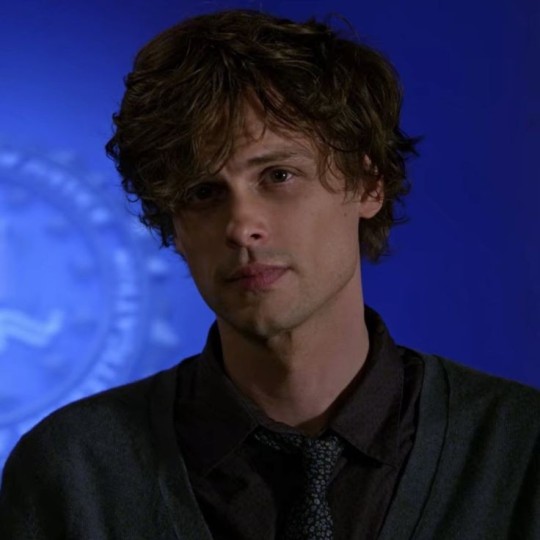
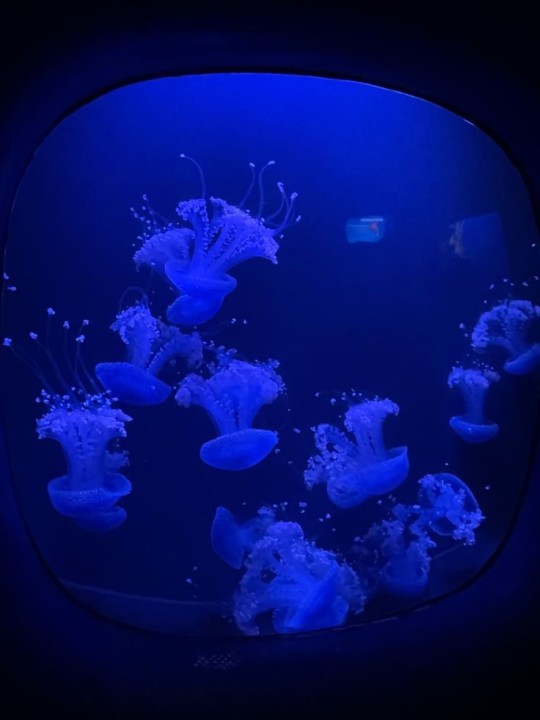
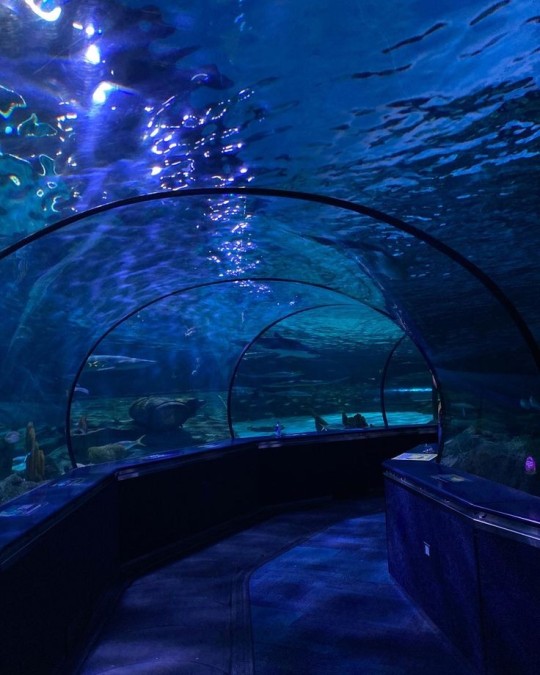
did you know that jellyfish are radially symmetrical? they are symmetrical because of a central axis that runs through the length of their body. They have an upper and lower part, but no left or right sides. They are different from other types of animals such as reptiles, fishes, birds and arthropods, which exhibit bilateral symmetry. I love them
#spencer reid#criminal minds#mgg#doctor spencer reid#mgg pics#spencer reid x reader#spencer reid fluff#spencer reid criminal minds#spencer reid x y/n#spencer reid x oc#spencer reid smut#spencer reid aesthetic#spencer reid moodboard#criminal minds moodboard#criminal minds imagine#mgg pic#mgg moodboard#moodboard#dating spencer reid#spencer reid x you#aquarium#jellyfish
524 notes
·
View notes